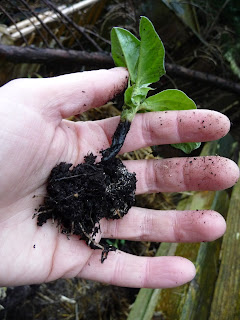The poly tunnel is starting to fill out with seeds trays, as is the green house, but even after my last job of potting on, more seedlings are in need of extra space. This week it's the turn of the peas and artichokes.
The peas I had sown early (November last year) were a variety called Kelvedon Wonder and by now although only about 2-3ins tall, they do need to be potted on from their small seed tray cells. I've carefully removed them to avoid as much root disturbance as possible (as peas seem to not like their roots disturbed much) and transplanted them to 0.5ltr pots. This gives them more room for now and extra nutrients from the additional compost I've had to use. I had originally sown about 30 seeds and roughly 70% have germinated. All in all, not bad. In my experience, you should never expect 100% success and beyond the germination stage, you could see more losses, as I did with my broad beans, which I will come to shortly.
Kelvedon Wonder peas: in their new home for now. I won't be repotting them again. Instead they will go out on the allotment in a few weeks.
The globe artichokes that I sowed during January needed potting on. Now, here's a tip to remember: I had placed them in heated propagators (see here about when I did this) and so they sprouted up quite quickly but with them came a pest! Luckily I took a close look and spotted greenfly on one of my seedlings! I promptly removed them as such an attack on my young plants could mean no success whatsoever. Always, always, always check your seedlings! You never know what lurks among them.
A little difficult to see but if you look closely at the central leaves at the top, you can see a cluster of aphids. A much larger aphid is seen lower down and was the one I spotted first.
When it came to checking my broad beans I was disappointed. The Bunyards Exhibition I thought would be good to grow had all but one succumbed to what looked like root rot. When I went to check them I noticed that they were all starting to look a little droopy and then I noticed that the base of the stems were black in colour. Not good. Here's what they looked like:
This was the view while they were in their pots. You can see the blackened stem where I'm pointing to.
Taking one out of its pot gave me a clearer view of the fungal damage caused. These plants won't recover and were thrown away.
Years back I would have probably cried over the loss (believe me this is true) as I would have felt extremely disappointed and would have thought that the whole thing was just a waste of time. This is why when I write about this I can't help but add that gardeners should always plan ahead, including for disasters, which in my mind this one was. Unlike the years where I would have cried because I wouldn't have had any other seeds, I've made sure that I will have more. The other variety that I had sown, Aquadulce Claudia, are currently growing well so I'm pleased with that. I will add further sowings as well to increase potential yield and lengthen my harvest time (at least, that's the idea).
So my advice for this week would be to keep an eye on anything that you are growing as diseases and pests are awakening. Make sure that seedlings are protected from the cold by cold frames or fleece and don't over water. Throw away any plants that have symptoms of fungal disease as it will spread to others.
Until next time.




No comments:
Post a Comment